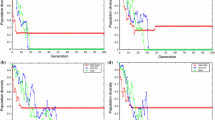Abstract
Based on some phenomena from human society and nature, we propose a binary affinity genetic algorithm (aGA) by adopting the following strategies: the population is adaptively updated to avoid stagnation; the newly generated individuals will be ensured to survive for some generations in order for them to have time to show their good genes; new individuals and the old ones are balanced to have the advantages of both. In order to quantitatively analyze the selective pressure, the concept of selection degree and a simple linear control equation are introduced. We can maintain the diversity of the evolutionary population by controlling the value of the selection degree. Performance of aGA is further enhanced by incorporating local search strategies.
Similar content being viewed by others
References
Back, T., D.B. Fogel, and Z. Michalwicz. (1997). Handbook of Evolutionary Computation. Oxford Univ. Press, London, U.K.
Davis, L. (1991). “Bit-Climbing, Representation Bias, and Test Suite Design.” In Proceedings of the Fourth International Conference on Genetic Algorithms, Morgan Kaufmann.
De Jong, K.A. (1975). An Analysis of the Behavior of a Class of Genetic Adaptive Systems. Doctoral Dissertation, Univerity of Michigan.
Goldberg, D.E. (1989). Genetic Algorithms in Search, Optimization and Machine Learning. Addison-Wesley, Reading, MA.
Herrera, F. and M. Lozano. (2000). “Gradual Distributed Real-Coded Genetic Algorithms.” IEEE Transactions on Evolutionary Computation 4(1), 43–63.
Holland, J.H. (1975). Adaptation in Nature and Artificial Systems. University of Michigan Press, Ann Arbor.
Huang, W.Q. and R.C. Jin. (1997). “The Quasi-Physical Personification Algorithm for Solving SAT Problem-Solar.” Science in China, Series E (2), 179–186 (in Chinese).
Huang, G.F. and A. Lim. (2003). “Designing a Hybrid Genetic Algorithm for the Linear Ordering Problem.” In Cantu-Paz E. et al. (eds.), GECCO2003, LNCS 2723, pp. 1053–1064.
Jin, X. and R.G. Reynolds. (1999). “Using Knowledge-based Evolutionary Computation to Solve Nonlinear Constrained Optimization Problems: A Cultural Algorithm Approach.” In Proceedings Congress Evolutionary Computation (CEC 1999) 3, 1672–1678.
Kim, J.Y., Y.K. Kim, and Y. Kim. (2003). “Tournament Competition and its Merits for Coevolutionary Algorithms.” Journal of Heuristics (9), 249–268.
Kuo, T. and S.Y. Huwang. (1996). “A Genetic Algorithm with Disruptive Selection.” IEEE Transactions on Systems, Man, and Cybernetics 26(2), 299–307.
Mahfoud, S.W. (1995). “Niching Methods for Genetic Algorithm.” Univ. Illinois at Urbana-Champaign, Illinois Genetic Algorithms Lab., IlliGAL Rep. 95001.
Michalewicz, Z. (1996). Genetic Algorithms + Data Structures = Evolution Programs, (3rd edn), Springer.
Potts, J.C., T.D. Giddens, and S.B. Yadav. (1994). “The Development and Evaluation of an Improved Genetic Algorithm Based on Migration and Artificial Selection.” IEEE Transactions on Systems, Man, and Cybernetics 24(1), 73–85.
Ray, T. and K.M. Liew. (2003). “Society and Civilization: An Optimization Algorithm Based on the Simulation of Social Behavior.” IEEE Transactions on Evolutionary Computation 7(4), 386–396.
Reynolds, R.G. and C.J. Chung. (1997). “A Cultural Algorithm Framework to Evolve Multiagent Cooperating with Evolutionary Programming.” In Proceedings Evolutionary Programming VI, pp. 323–333.
Schaffer, J.D., R.A. Caruana, and L.J. Eshelman et al. (1989). “A Study of Control Parameters Affecting Online Performance of Genetic Algorithms.” In Proceedings 3rd Int. Conf. Genetic Algorithms, pp. 51–60.
Szalas, A. and Z. Michalewicz. (1993). “Contractive Mapping Genetic Algorithms and Their Convergence.” Department of Computer Science, University of North Carolina, Technical Repeot, 006-1993.
Whitley, D. (1989). “The GENITOR Algorithm and Selective Pressure: Why Rank-Based Allocation of Reproductive Trials is Best.” In Proceedings 3rd Int. Conf. Genetic Algorithms, pp. 42–50.
Williams, G.C. (1996). Adaption and Natural Selection: A Critique of Some Current Evolutionary Thought. Princeton Univ. Press.
Wolpert, D.H. and W.G. Macready. (1997). “No Free Lunch Theorems for Optimization.” IEEE Transactions on Evolutionary Computation 1(1), 67–82.
Yao, X., Y. Liu, and G.M. Lin. (1999). “Evolutionary Programming Made Faster.” IEEE Transactions on Evolutionary Computation 3(2), 82–102.
Zhao, X.C. (2005). “A Greedy Genetic Algorithm for Unconstrained Global Optimization.” Journal of Systems Science and Complexity 18(1), 102–110.
Zhao, X.C. and H.L. Long. (2005). “Multiple Bit Encoding-based Search Algorithms.” In Proc. 2005 IEEE Congress on Evolutionary Computation, IEEE Press, pp. 1996–2001.
Zhou, M. and S.D. Sun. (1999). Genetic Algorithms: Theory and Applications (in Chinese). National University of Defense Technology Press, China.
Author information
Authors and Affiliations
Corresponding author
Additional information
Partially supported by a National Key Basic Research Project of China and by a USA NSF grant CCR-0201253.
Rights and permissions
About this article
Cite this article
Zhao, X., Gao, XS. Affinity genetic algorithm. J Heuristics 13, 133–150 (2007). https://doi.org/10.1007/s10732-006-9005-z
Published:
Issue Date:
DOI: https://doi.org/10.1007/s10732-006-9005-z




